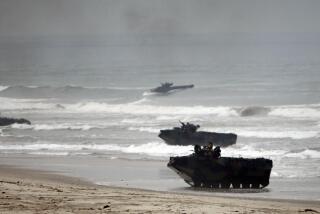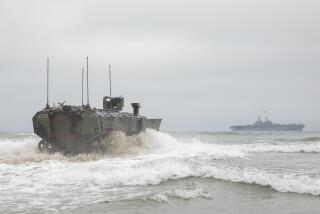Marine assault vehicles key to Afghan strategy
- Share via
Reporting from Camp Pendleton — Weighing 70 tons, traveling up to 45 mph and possessed of a smash-mouth name, the Assault Breacher Vehicle is the Marine Corps’ latest answer to a perennial problem of offensive warfare: how to push through the barriers and booby traps of an enemy’s outer defenses.
Over the decades, Marines have used various strategies to breach defenses, involving heavy vehicles or, in some cases, sending Marine engineers into minefields to set, by hand, line charges loaded with explosives.
“Breaching is always the hardest part of an assault,” said Sgt. Carl Hewett, a breacher operator stationed here.
In the 1990s, the U.S. Army decided it could not afford to continue developing such a complicated, maintenance-heavy vehicle. But the Marine Corps persisted -- funding the development and testing from its own discretionary budget funds.
In December, the 42-foot-long assault breacher was used in combat for the first time, as Marines pushed into a Taliban stronghold called Now Zad in Afghanistan’s Helmand province. The brass were pleased with its performance.
Now, as the Marines plan a much larger and more complex assault in the same province, the vehicles, which cost $3.75 million each, are being touted as part of a strategy for routing Taliban fighters.
The top Marine general in Afghanistan, Brig. Gen. Larry Nicholson, has made it no secret that he plans a massive assault against the Taliban-held community of Marja, where hundreds, maybe thousands, of Taliban took refuge last summer when battalions of Marines swept into Helmand.
From Marja, the Islamist militants, who were toppled from power in Afghanistan in late 2001 by U.S. and allied forces, have been able to plot assassinations of Afghan officials, concoct the roadside bombs that are the No. 1 killer of U.S. and Afghan forces, and control the cultivation and sale of the area’s poppy crop, which is turned into heroin and helps fund the insurgency.
Marja is located 380 miles southwest of Kabul, the national capital. Taliban forces have had months to bury roadside bombs in anticipation of an assault by Western troops. Increasing the difficulty, the land is broken up by irrigation canals, built by the U.S. in the 1950s and 1960s, that could stop the advance of tanks and other assault vehicles.
Enter the breacher, a cross between a tank and a bulldozer, armed with a .50-caliber machine gun and grenade launcher, powered by a 1,500-horsepower turbine engine, and manned by a driver and an operator of the vehicle’s weapons and communications systems.
“Anywhere a tank can go, we can go,” Hewett said.
The breacher operator fires line charges loaded with explosives. Once the lengthy lines hit the ground, they can be detonated by the operator from inside the vehicle. The pressure of the explosives is designed to detonate any roadside bombs buried by an enemy.
Two breachers, side by side, are meant to clear a path wide enough for other vehicles and infantry troops. The scoops on the front of the vehicles can help deflect the explosion from buried bombs; a different scoop can fill irrigation canals with dirt to permit passage.
A Marja assault could be months away. The Marines’ assault last year into Helmand was made in early July, the hottest month in one of the hottest spots in Afghanistan.
The Marja campaign will involve Marines and Afghan soldiers and will probably be seen as a major test for the Afghans, whose army is still in the formative stage. Eight senior Afghan officers were recently hosted by Marines at Quantico, Va., Camp Pendleton and Twentynine Palms.
“Afghans have been fighting for 30 years,” Afghan Lt. Col. Abdulltai Nashat told reporters at Camp Pendleton. “They will fight forever -- don’t worry about that.”
And where do the Marines expect the Taliban fighters to go?
“To their graves,” said Nicholson at the Marine base in Afghanistan.
More to Read
Sign up for Essential California
The most important California stories and recommendations in your inbox every morning.
You may occasionally receive promotional content from the Los Angeles Times.










